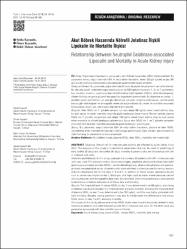| dc.contributor.author | Aksebzeci, Bekir Hakan | |
| dc.contributor.author | Kayaaltı, Seda | |
| dc.contributor.author | Kayaaltı, Ömer | |
| dc.date.accessioned | 2019-06-25T06:40:10Z | |
| dc.date.available | 2019-06-25T06:40:10Z | |
| dc.date.issued | 2018 | en_US |
| dc.identifier.issn | 2602-2974 | |
| dc.identifier.other | DOI: 10.4274/tybd.86158 | |
| dc.identifier.other | Accession Number: WOS:000452006700004 | |
| dc.identifier.other | IDS Number: HC7UI | |
| dc.identifier.uri | http://acikerisim.agu.edu.tr/xmlui/handle/20.500.12573/14 | |
| dc.description.abstract | Objective: Almost half of intensive care patients are affected by acute kidney injury (AKI). The purpose of this study is to determine parameters that can be used for predicting of early (within 28 days) and late (within 90 days) mortality in patients who are followed-up with AKI in intensive care units. Materials and Methods: In this study, a dataset that contains 50 patients with AKI in intensive care units was used. This dataset contains blood urea nitrogen, creatinine, plasma and urinary neutrophil gelatinase-associated hpocalin (NGAL), lactate dehydrogenase, alkaline phosphatase and gammaglutamyl transpeptidase values of patients who were admitted to intensive care for various reasons and who developed AKI on the days 1, 3 and 7. In addition to these values, laboratory results such as serum electrolytes on day 1, blood gas; vital signs such as mean arterial pressure, central venous pressure; and demographic data were also recorded. Data mining techniques were applied to determine correlation between all of these data and mortality. Results: The threshold level of urinary NGAL on day 7 was determined to be 69 ng/mL, and strong correlation was found between this threshold level and early mortality. Similarly, the threshold level of plasma NGAL on day 7 was determined to be 150 ng/mL, and this was highly correlated with early mortality. Besides, strong correlation was also found between the difference in the urinary NGAL levels on day 1 and 7, and early mortality. Conclusion: In this study, plasma and urinary NGAL levels were found to be closely related to early mortality in patients who were followed-up with AKI in intensive care units. On the other hand, any parameter associated with late mortality was not found. | en_US |
| dc.language.iso | tur | en_US |
| dc.publisher | GALENOS YAYINCILIK, ERKAN MOR, MOLLA GURANI CAD 21-1, FINDIKZADE, ISTANBUL 34093, TURKEY | en_US |
| dc.relation.ispartofseries | TURKISH JOURNAL OF INTENSIVE CARE-TURK YOGUN BAKIM DERGISI;Volume: 16 Issue: 3 Pages: 101-108 | |
| dc.rights | info:eu-repo/semantics/openAccess | en_US |
| dc.subject | Acute kidney injury | en_US |
| dc.subject | plasma NGAL | en_US |
| dc.subject | urinary NGAL | en_US |
| dc.subject | mortality | en_US |
| dc.subject | data mining | en_US |
| dc.title | Akut Böbrek Hasarında Nötrofil Jelatinaz İlişkili Lipokalin ile Mortalite İlişkisi | en_US |
| dc.title.alternative | Relationship Between Neutrophil Gelatinase-associated Lipocalin and Mortality in Acute Kidney Injury | |
| dc.type | article | en_US |
| dc.contributor.department | AGÜ, Yaşam ve Doğa Bilimleri Fakültesi, Biyomühendislik Bölümü | en_US |
| dc.contributor.institutionauthor | | |
| dc.identifier.doi | 10.4274/tybd.86158 | |
| dc.relation.publicationcategory | Makale - Uluslararası Hakemli Dergi - Kurum Öğretim Elemanı | en_US |


















